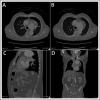Chronic Cough as a Presenting Symptom of a Giant Thoracic Aortic Aneurysm: A Case Report
- PMID: 34355195
- PMCID: PMC8334076
Chronic Cough as a Presenting Symptom of a Giant Thoracic Aortic Aneurysm: A Case Report
Abstract
Chronic cough has a broad differential, and thoracic aortic aneurysm (TAA) is a rare but potentially life-threatening etiology. We present a giant arch TAA in a non-dyspneic, Pacific Islander man with significant tobacco-use history who presented with chronic cough with no acute pulmonary process noted on imaging. Given the high mortality rates associated with thoracic aortic aneurysms, the purpose of this report is to highlight the importance of keeping TAA as a rare differential for chronic cough, particularly when caring for patients with elevated risk. Recognition of patients with thoracic aortic disease who have a class I indication for surgical intervention (meaning there is evidence or general agreement that surgery will be beneficial, useful, and effective) as well as prompt evaluation of their anatomical landmarks in the perioperative period is critical. Imaging and, in particular, computed tomography remain the optimal modalities to screen for thoracic aortic disease.
Keywords: Aneurysm; Cardiology; Cardiothoracic Surgery; Internal Medicine; Thoracic Aortic Disease.
©Copyright 2021 by University Health Partners of Hawai‘i (UHP Hawai‘i).
Figures




Similar articles
-
Chronic cough: a herald symptom of thoracic aortic aneurysm in a patient with a bicuspid aortic valve.BMJ Case Rep. 2014 Sep 1;2014:bcr2014205005. doi: 10.1136/bcr-2014-205005. BMJ Case Rep. 2014. PMID: 25178892 Free PMC article.
-
Endovascular stent grafting and open surgical replacement for chronic thoracic aortic aneurysms: a systematic review and prospective cohort study.Health Technol Assess. 2022 Jan;26(6):1-166. doi: 10.3310/ABUT7744. Health Technol Assess. 2022. PMID: 35094747
-
Delayed presentation of posttraumatic aortic false aneurysm with chronic cough.Am J Med Sci. 2009 Dec;338(6):525-6. doi: 10.1097/MAJ.0b013e3181b5264e. Am J Med Sci. 2009. PMID: 19875953
-
Surgical treatment of an aneurysm of the aberrant right subclavian artery involving an aortic arch aneurysm and coronary artery disease.Ann Thorac Cardiovasc Surg. 2001 Apr;7(2):109-12. Ann Thorac Cardiovasc Surg. 2001. PMID: 11371282
-
[Thoracic aortic aneurysm].Chirurg. 2012 Apr;83(4):395-404; quiz 405. doi: 10.1007/s00104-011-2242-1. Chirurg. 2012. PMID: 22476134 Review. German.
References
Publication types
MeSH terms
LinkOut - more resources
Full Text Sources

